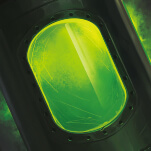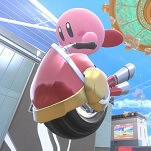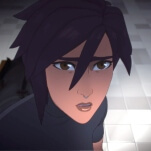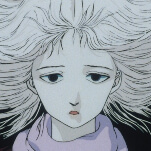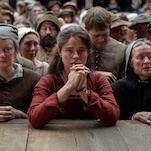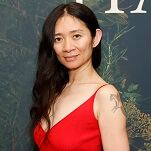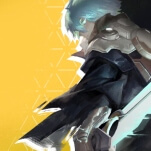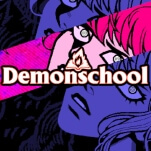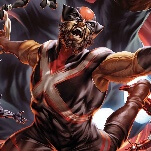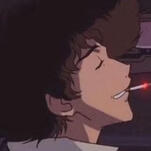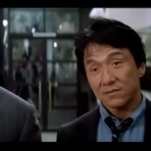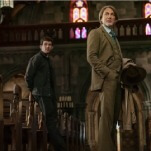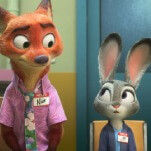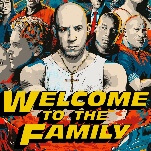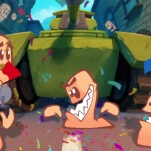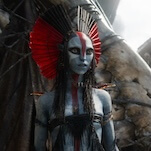Yumi Sakugawa’s sublime Ikebana takes full advantage of the comics medium
Your Illustrated Guide To Becoming One With The Universe cartoonist Yumi Sakugawa writes primarily with metaphors. There is an ambiguity and a complexity to everything she does. Ikebana (Retrofit)—a story about Cassie Hamasaki and her art school senior thesis, and the cartoonist’s most recent release—is no different.
The title, which is explained in the comic, and which refers to the Japanese art of flower arrangement, serves as a foundation upon which everything else is built. Cassie’s goal is to merge the act of living and the act of ikebana, and, in the vein of that tradition’s practices, remains silent throughout the story’s tumult. But like the meditative, spiritual practice of ikebana, the meaning of Cassie’s blurring of living and art-making is polysemantic. For example, she begins the story standing in a bowl of water and concludes it floating in the ocean—the abyssal expanse effectively approximated by fat strokes of lush, black ink. This may be read as representing the transition from the “small pond” of college to the “big pond” of real life. Ikebana is poetic in that way; its narrative is short and ambiguous, and its lingua franca is figurative language. It’s more of an agglomeration of interrelated ideas than a narrative, and it’s fecund enough to sustain multiple readings.
A contributing factor to the elusive, slippery quality of Sakugawa’s writing is her art. Sakugawa’s lines are abrasive and bristling with a raw emotionality—the Platonic ideal of James Kochalka’s “Craft Is The Enemy” manifesto—and consciously or not, her style is thematically resonant with the art of ikebana’s emphasis on minimalism. This is evident in her figurework; she often leaves her characters without mouths or pupils or eyebrows, but she is able to achieve her intended affect without those things. She eschews the saccharine sentimentality that sinks the Chris Ware imitators of the world (the ones who are responsible for the perceived interchangeability of “indie comic” and “sad white boy discovers sex”), and she allows her ideas—her images—to do the communicating. In this way, the work is as much a montage as it is anything else; the meaning of images are created and altered by the way Sakugawa organizes and juxtaposes them.
This montage-like style of storytelling is deeply effecting, and Sakugawa has become transcendently skilled at using the Derridean arch-writing quality of comics (not just the interplay between images and text but the manipulation of images as text) to communicate both the sublime and the profoundly ineffable. For all of Ikebana’s merits, this is its most subtle and important. It’s difficult to imagine her work existing in any other medium and still holding the same weight, still having the same impact. Ikebana lives and thrives—totally and completely—in the medium for which it was intended. [Shea Hennum]
Despite her frequent protests that she would not be a very good editor, Gail Simone has proven to be quite adept at gathering talented creators around her to tell sprawling, interconnected stories. With the success of the Legends Of Red Sonja miniseries, it was only a matter of time before Simone and Dynamite decided to take another pass at a similar project, and that turned into this summer’s Swords Of Sorrow event, a fun, fantasy-driven jaunt through Dynamite’s properties, pulling characters back into the ring after years languishing on the bench. Many of the stories center around characters not nearly as familiar as Red Sonja or Vampirella, to say nothing of characters at other publishers. Mikki Kendall, who’s better known for her prose fiction and online activism, is at the helm of Swords Of Sorrow: Miss Fury & Lady Rawhide (Dynamite), one of four one-shot issues. Kendall has just a single issue to establish the personalities of two heroes and two villains, not to mention tell a compelling story. She does an remarkable job, particularly since she has to make sure that the story makes sense both with and without the context of the rest of the Swords Of Sorrow issues.
Miss Fury and Lady Rawhide begin the issue at odds, tossed into a chaotic world where the former’s 1942 New York and the latter’s 1832 Mexico have been smashed together for some nefarious purpose. The plot moves along quickly, hitting strong beats as the heroes overcome their initial distrust and work together to thwart the threats they face. There are a couple of moments that land awkwardly, almost exclusively because of the nature of being an event tie-in issue: Miss Fury & Lady Rawhide isn’t the first comic to suffer from a slight lack of larger context, and it certainly won’t be the last, but the story is strong enough that it recovers gracefully from these minor stumbles. It doesn’t help that, with some rare exceptions, editor’s notes in comics aren’t as common as they once were. Even readers who haven’t been checking out the rest of Swords Of Sorrow will be able to follow Fury and Rawhide in their adventures without trouble.
Artist Ronilson Freire, who has worked for Dynamite in the past on Mark Waid’s The Green Hornet and Justice Inc: The Avenger, has an old-school, pulpy style that works well for this book. There are a couple of panels with Escher Girl issues, but they’re a lot easier to forgive in context than some other examples are. That pulpiness may actually be the biggest problem for the whole Swords Of Sorrow project. Several of the covers, particularly those by J. Scott Campbell, are so mismatched to the tone and intention of the interiors that there’s little doubt some readers were chased off by the over-the-top cover art. Simone has done a great job of pulling Red Sonja back from “just eye candy” status, and Swords Of Sorrow is doing much of the same important work for other characters. But stylistically, pulp and overt hyper-sexualization have been tied together for so long that it’s difficult to find a way to separate the two, though DC Bombshells seems to be doing a great job so far with the similarly difficult pin-up art style. Simone’s a huge draw for comic neophytes and under-represented groups, and a big event like this has the opportunity to pull in a lot of new readers, but some of the art may have seriously limited its appeal. Kendall and Freire, along with colorist Kirsty Swan and letterer Erica Schultz, delivered an issue that’s both fun and funny with a retro feel and a strong pulp-but-not-porn sensibility. It’s a shame that it feels like Dynamite didn’t quite hold up its end of the bargain. [Caitlin Rosberg]

